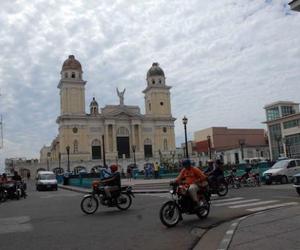In Cuba, Much Work Remains 6 Months After Sandy
- Submitted by: lena campos
- Santiago de Cuba
- 04 / 25 / 2013

Many people in eastern Cuba are still living with family or in houses covered by flimsy makeshift rooftops six months after Hurricane Sandy pummeled the island's eastern provinces, residents and aid workers said Thursday.
Many praised the government's efforts to rebuild Santiago and other cities but said much work remains to recover from the storm, which caused 11 deaths in Cuba before raging up the U.S. Atlantic Seaboard and killing 72.
"It was very hard-hit, but Santiago is once again blossoming," Aristides Zayas, a receptionist in Santiago said in a phone interview. "Of course the magnitude was such that not everything can get off the ground in six months. It will take time."
The half-year mark comes amid preparations for similar commemoration by states up and down the U.S. East Coast, where Sandy blew ashore in New Jersey on Oct. 29 as a monster storm that resulted in billions of dollars in damage.
Sandy had raked eastern Cuba four days earlier, causing major crop losses and damaging an estimated 130,000 to 200,000 homes. The government has not said how many of those have yet to be repaired or rebuilt.
Cuban scientists say Sandy's surge penetrated 50 yards (meters) inland and permanently altered much of the eastern coastline, washing away entire beaches and depositing sand elsewhere.
Shortly after the storm hit, Cuban President Raul Castro visited Santiago and said the city looked like it had been "bombed."
Cuba's highly organized civil defense brigades mobilized to get newly homeless people into shelters, distribute food and water and replant uprooted trees. Authorities also extended loans for rebuilding and knocked 50 percent off the price of home materials for storm victims.
Communist Party newspaper Granma said Thursday that for visitors today, "the first thing that catches one's attention and impresses ... is to find a clean and well-ordered city."
But residents said problems remain.
"From what I hear some things are still lacking," said Sister Mirtha, a Roman Catholic nun in the town of El Cobre, 30 miles (50 kilometers) east of Santiago. "Some people have roofs, but others still do not. There are people who are getting rained on, and it's thanks to neighbors that they have somewhere to go."
She said some who live in informal housing situations have had difficulty getting their hands on building materials, because residents are required to show property titles to get the discounted items.
An international aid worker who has been closely involved in the relief effort said construction materials like bricks and corrugated iron rooftops are in short supply since local production is not meeting demand, and many items must be imported. Some families have moved back into damaged homes with just plastic sheets covering the roofs.
"They've done really well on re-establishing access to services like electricity and water, reopening roads, clearing out trees that have fallen down," the person said, speaking on condition of anonymity in order to maintain the organization's relationship with island authorities. "All of that was quite quick given the scale of the impact."
"But at the individual level there's still a lot of work that needs to be done ... and my sense is that the government can't tend to every family's individual needs."
Source: ABC News.go.com
Comments